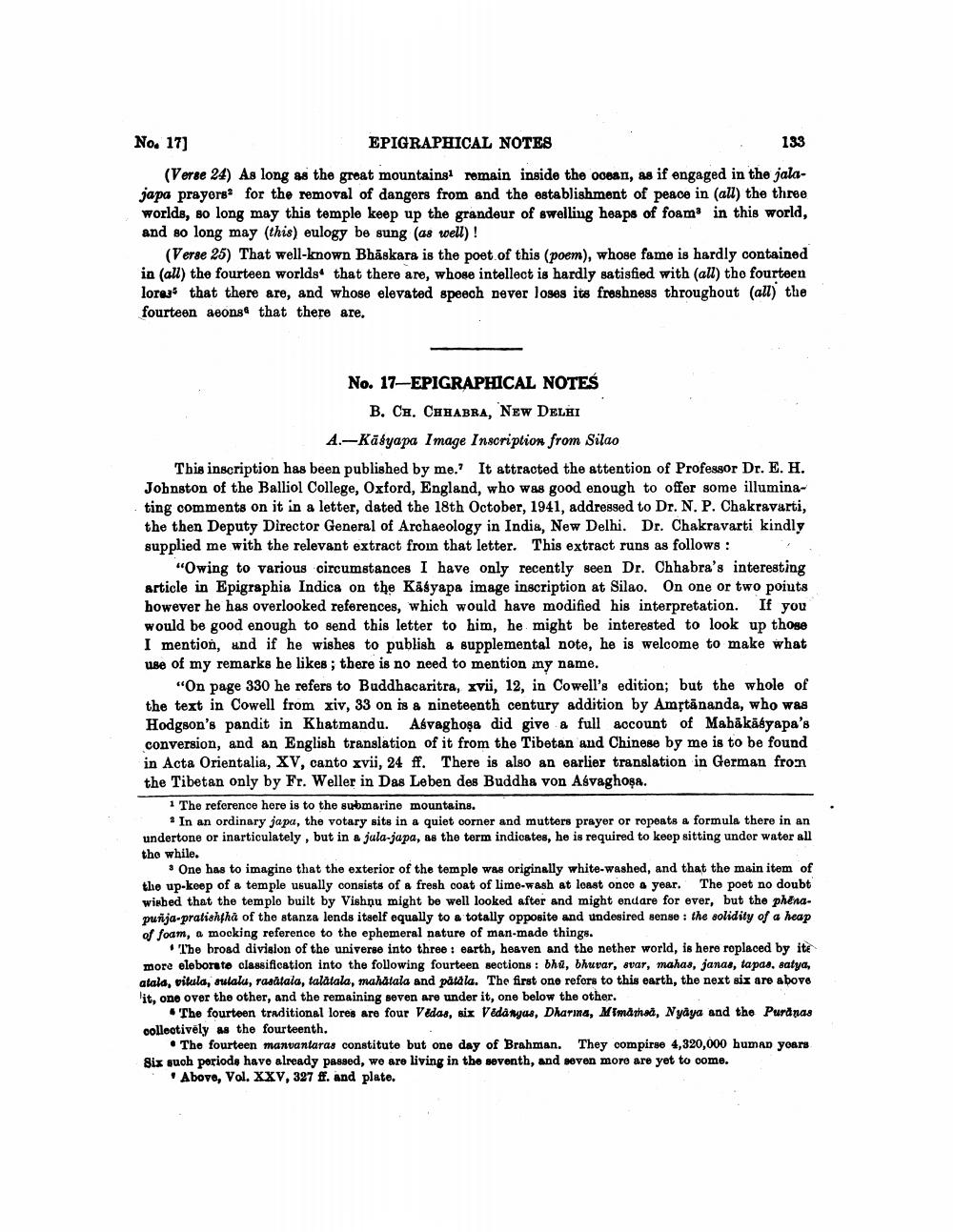________________
No. 17) EPIGRAPHICAL NOTES
133 (Verse 24) As long as the great mountains remain inside the ocean, as if engaged in the jalaja pa prayors for the removal of dangers from and the establishment of peace in (all) the three worlds, so long may this temple keep up the grandeur of swelling heaps of foams in this world, and so long may (this) eulogy be sung (as well)!
(Verse 25) That well-known Bhāskara is the poet of this (poem), whose fame is hardly contained in (all) the fourteen worlds that there are, whose intellect is hardly satisfied with (all) the fourteen lores that there are, and whose elevated speech never loses its freshness throughout (all) the fourteen avons that there are.
No. 17–EPIGRAPHICAL NOTES
B. CH. CHHABRA, NEW DELHI
A.-Kāsyapa Image Inscription from Silao This inscription has been published by me. It attracted the attention of Professor Dr. E. H. Johnston of the Balliol College, Oxford, England, who was good enough to offer some illuminating comments on it in a letter, dated the 18th October, 1941, addressed to Dr. N. P. Chakravarti, the then Deputy Director General of Archaeology in India, New Delhi. Dr. Chakravarti kindly supplied me with the relevant extract from that letter. This extract runs as follows:
"Owing to various circumstances I have only recently seen Dr. Chhabra's interesting article in Epigraphia Indica on the Kasyapa image inscription at Silao. On one or two poiuts however he has overlooked references, which would have modified his interpretation. If you would be good enough to send this letter to him, he might be interested to look up those I mention, und if he wishes to publish a supplemental note, he is welcome to make what use of my remarks he likes ; there is no need to mention my name.
"On page 330 he refers to Buddhacaritra, xvii, 12, in Cowell's edition; but the whole of the text in Cowell from xiv, 33 on is a nineteenth century addition by Amstänanda, who was Hodgson's pandit in Khatmandu. Asvaghosa did give a full account of Mabākābyapa's conversion, and an English translation of it from the Tibetan and Chinese by me is to be found in Acta Orientalia, XV, canto xvii, 24 ff. There is also an earlier translation in German fron the Tibetan only by Fr. Weller in Das Leben des Buddha von Asvaghosa.
1 The reference here is to the submarine mountains.
* In an ordinary japa, the votary sits in a quiet corner and mutters prayer or ropeats a formula there in an undertone or inarticulately, but in a jula-japa, as the term indicates, he is required to keop sitting under water all the while.
* One has to imagine that the exterior of the temple was originally white-washed, and that the main item of the up-keep of a temple usually consists of a fresh coat of lime-wash at loast onoo & year. The poet no doubt wirbed that the templo built by Vishnu might be well looked after and might endare for ever, but the phéna. puñja-pratishtha of the stanza lends itself equally to a totally opposite and undesired sense : the solidity of a heap of foam, a mocking reference to the ephemeral nature of man-made things.
• The broad division of the universe into three : earth, heaven and the nether world, is here roplaced by ite more eleborate classification into the following fourteen sections : bhū, bhuvar, svar, mahas, janas, tapas, satya, atala, vitila, sulalu, rasátala, talatala, mahatala and pätala. The first one refors to this earth, the next six are above lit, one over the other, and the remaining seven are under it, one below the other.
• The fourteen traditional lores are four Vedas, six Védanyas, Dharina, Mimamaa, Nyaya and the Puranas collectively as the fourteenth.
• The fourteen manvantaras constituto but one day of Brahman. They compirse 4,320,000 human years Six such periode have already passed, we are living in the seventh, and seven more are yet to come.
Above, Vol. XXV, 327 ff. and plate.




